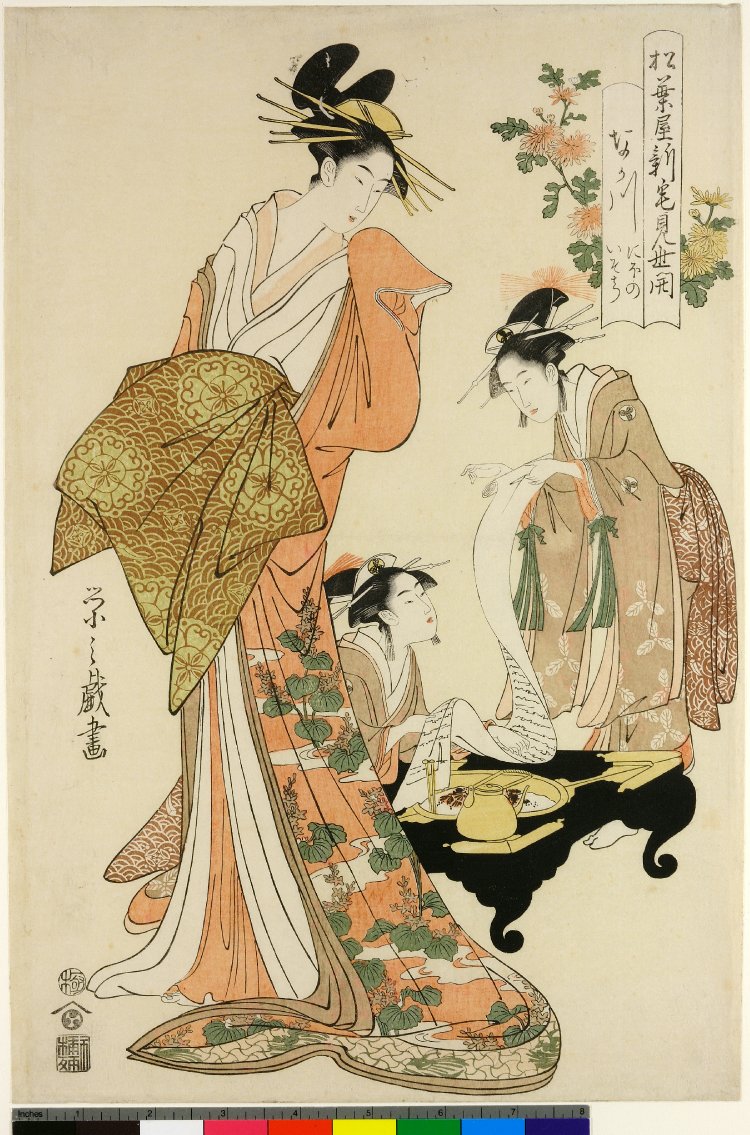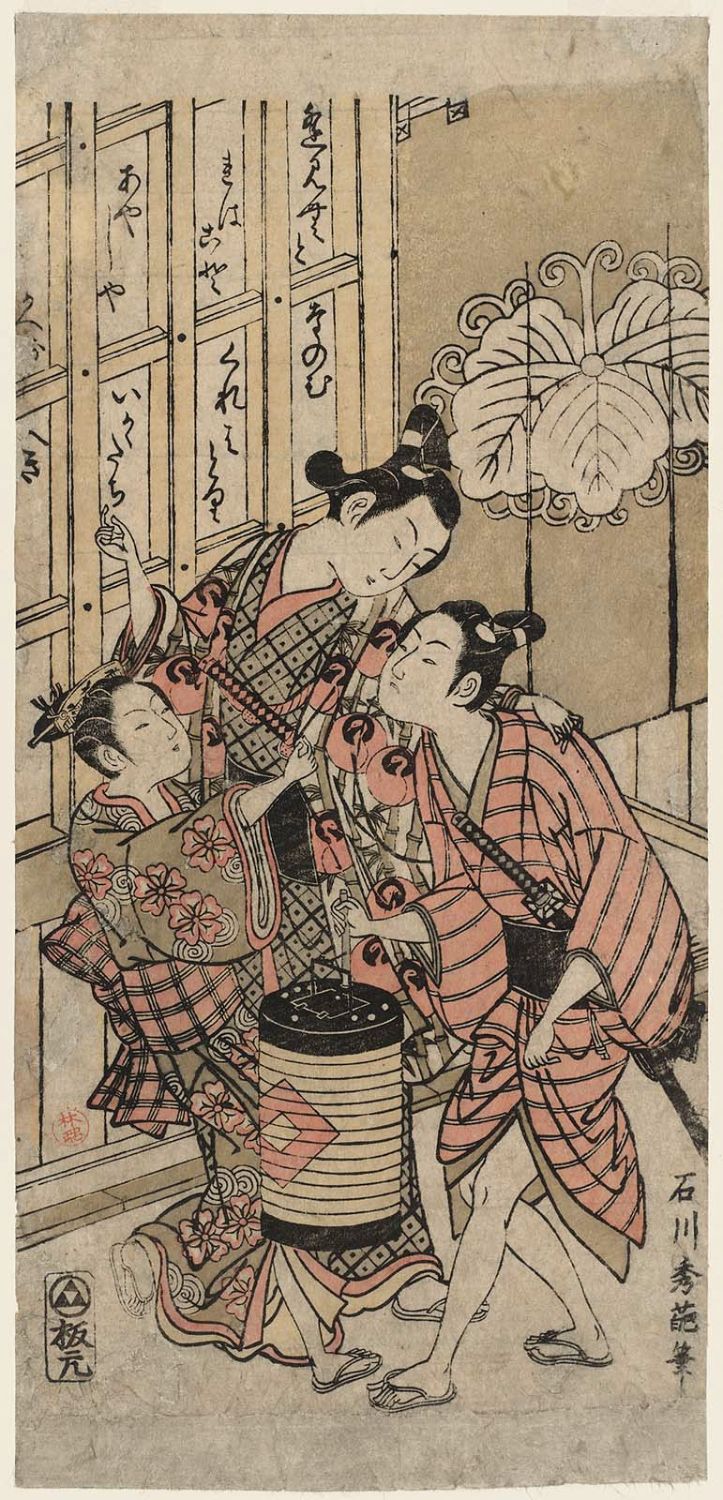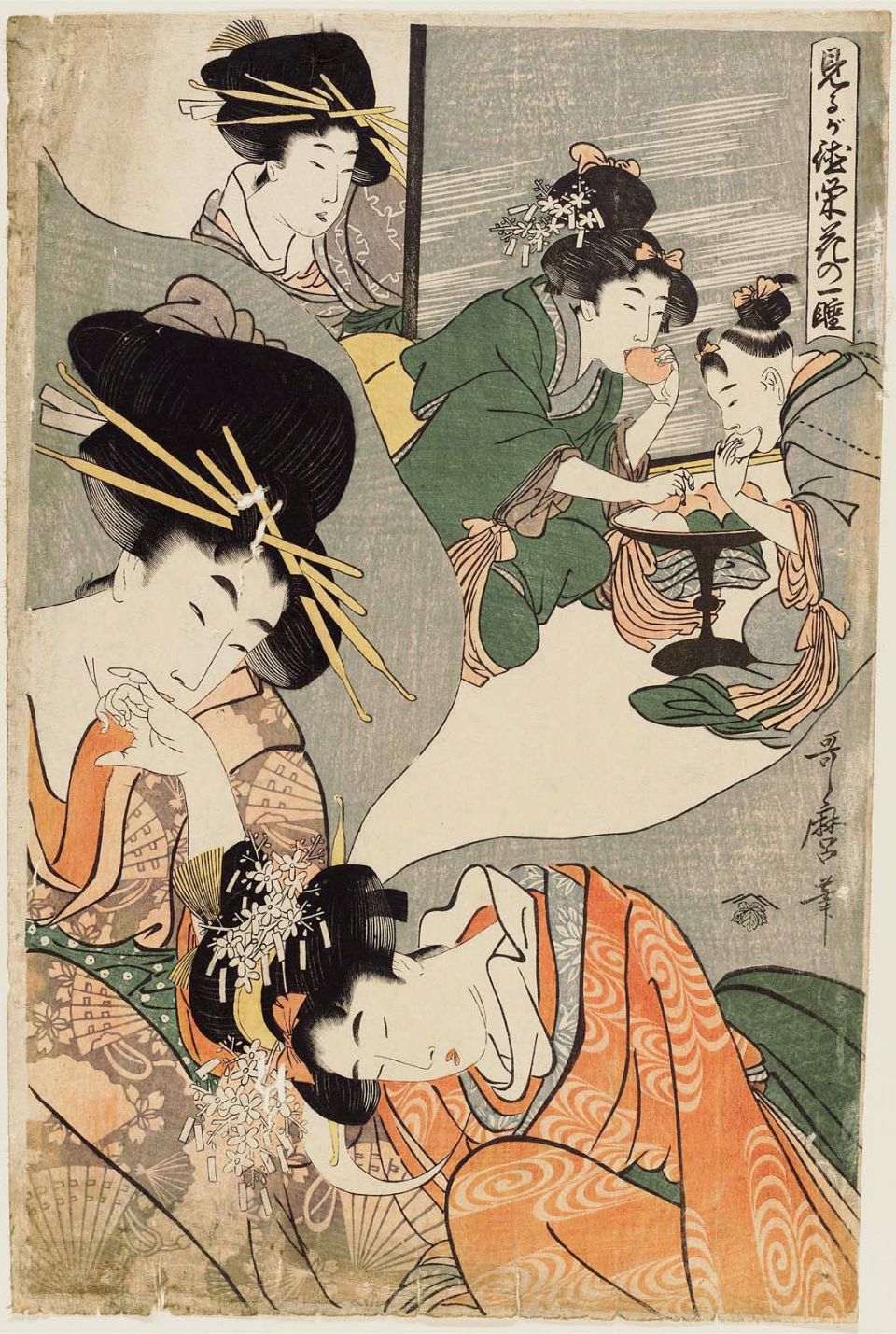Kamuro

The courtesan Nakagawa of the newly opened Matsubaya house listens as her kamuro, Niono and Isochi, lean over the brazier reading a love letter addressed to Nakagawa.
"The Opening of the New Premises of the Matsubaya," by Hosoda Eichi, circa 1795. [link] © Trustees of the British Museum
Kamuro were the small girls who attended the great courtesans of the Yoshiwara. Brought into service at the age of five to nine, they paraded in their "older sister" courtesan's retinue when she appeared in public, ran errands for her, and attended her when she met with clients. The streets of the Yoshiwara were lively with brightly dressed little girls going to and fro, carrying orders to merchants, calling on vendors, delivering gifts, trading jokes with the locals, buying snacks for their older sisters to eat hurriedly between clients. They were participants in the life of the Yoshiwara just as much as their older sisters, laughing at samurai visitors' boorish manners and composing haiku about life in the Yoshiwara.

A kamuro hangs on the haori of a stylish young man. He seems intrigued; his friend is less pleased. Kamuro were often shown clinging to their older sisters' customers to detain them. They were also taught tricks like running up to a client in the street, clinging to his arm, and calling him by the wrong name. Caught off guard, he would correct her, accidentally revealing his real name, which he had been trying to keep secret. This young kamuro may be trying to convince one of her older sister's regular customers that her older sister was simply dying for a visit.
"Kamuro Accosting a Young Man," by Ishikawa Toyonobu, 18th century. [link] © Museum of Fine Arts, Boston
As you might guess, they were cosseted but not sheltered from the realities of life in the pleasure district. They knew what their older sisters did to earn their keep. Sometimes they helped: A client might pump his favorite courtesan's kamuro for information about how the courtesan felt about him, because the kamuro, innocent child that she was, could be trusted to tell the truth; the innocent child knew to give innocent answers that led the client to believe the courtesan was in love with him. Games like this were as much part of her education as her lessons in calligraphy and music. She knew someday she would be playing the same game from the other angle. She idolized the highest-ranking courtesans as queens of the Yoshiwara, and the Yoshiwara as the finest place on earth; her goal was to become a courtesan as fine as her older sister, and have kamuro of her own.
In the meantime, she was her older sister's charge in a way that maiko with an older sister were not. The relationship between a maiko and her older sister is largely ceremonial; the geisha introduces her younger sister to society, teaches her how to behave, and helps her to establish herself socially, but the maiko's okiya bears the expense of the maiko's training and debut, houses her, feeds her, and provides her kimono and ornaments. A courtesan was personally responsible for feeding, clothing, and sheltering her kamuro. If the courtesan didn't work, the kamuro starved. In return, the kamuro spent much of her time directly serving her older sister, whether as an errand girl or as a splendidly dressed status symbol. And if the kamuro debuted as a courtesan, her older sister bore the staggering costs herself.

Asleep at her post, a kamuro dreams of stuffing herself in the company of a younger friend.
"Dream of the Kamuro," from the series Profitable Visions in Daydreams of Glory, by Kitagawa Utamaro I, 1801-02. [link] © Museum of Fine Arts, Boston
This does not mean the courtesan owned the kamuro's contract. The courtesan's brothel obtained the little girl, either from parents native to the Yoshiwara who considered a term as a kamuro to be a logical first step in the girl's career, or from poor peasants who needed money badly enough to sell their daughter into prostitution. However, the brothel-keepers didn't necessarily contract the girls for the term of their working lives. They often hired the girls only for their term as kamuro, an arrangement that let the brothel-keepers avoid paying hefty sums up front for girls who failed to live up to their early promise. The expectation was that when the girl was ready to graduate to prostitution, her bond would be renewed for a prostitute's usual 10-year contract.
However, her parents or procurer could arrive for the contract negotiation armed with a better offer from another brothel. There was nothing the brothel-keepers could do to prevent them from taking her away and selling her to another brothel, taking with her all the care and money put into her training.
I haven't found any source that says what the kamuro thought of this. Some might have been happy to be shut of their former brothel, especially if the staff were cruel. Others were probably miserable at being ripped away from their home, their beloved older sister, and the future they had been promised there. A few may have considered it a stroke of luck; brothels were graded by the ranks of courtesans they owned, and an especially talented girl would have more scope for her ambition at a higher-ranked house. On the other hand, if a lower-ranked house offered her parents more money, a girl might lose the chance to become a courtesan at all. Fortunately or unfortunately, most kamuro seem not to have been reclaimed and resold by their parents. They finished their terms as kamuro and started work in the same house where they grew up.
Kamuro as Status Symbols
Kamuro were potent status symbols. These untrained little girls, with their country accents and grade-schooler naughtiness, were reserved as attendants to only the highest-ranking courtesans. At first a courtesan could have only one kamuro, but in the early 1700's a daring courtesan named Miyakoji took to parading with two kamuro. When the people in charge of enforcing the Yoshiwara's regulations challenged her on this unheard-of ostentation, she primly replied that only one kamuro was her own; the other belonged to one of her sister courtesans. That started a fashion for walking out with two kamuro, only one of which was supposedly your own. Eventually the authorities gave in and codified the new rule: the highest courtesans could have two kamuro, lower-ranking courtesans could have one, ordinary prostitutes of any rank could have none.
As status symbols, pairs of kamuro were made as much as possible into a matched set. Ideally, they were the same height; their hair was dressed identically, or one girl was given a girl's hairstyle and the other was given a boy's hairstyle; they were dressed in matching kimono and ornaments; and they were given matching names.
Kamuros' Names
Kamuros' names were simple, in contrast with the courtesans' often flowery names. They were usually written in katakana, a less learned and more childish script, rather than in the more sophisticated kanji. And they were created as a pair: Iroha (Color) and Nioi (Scent), or Chidori (Sandpiper) and Namiji (Trail of Waves). The two names could also have a more erudite theme, such as Kureha and Ayaha, names of famous weavers from two different ancient Chinese kingdoms. They could even reproduce a line of poetry: Fujino + Takane = "the high summit of Mt. Fuji."
Some of the most popular combinations were:
Futaba and Midori (Bud and New Greenery)
Hanano and Haruno (Flowery Field and Spring Field)
Hatsune and Kochô
Kanomo and Konomo
Onami and Menami (Big Waves and Little Waves)
Sodeno and Wakaba
Takeno and Sasano
Utagi and Utano
Even though courtesans could have several people in their retinue, the only members who are usually named in association with them are their kamuro. This is true even when the courtesan is depicted with their attendant shinzô; the kamuro are named, the shinzô, almost never. Even when the courtesan is depicted alone, her kamuros' names may be written in smaller letters beside the her name, as though they were waiting on the courtesan even in inked form.
To be honest, I have no idea why kamuro were so important. None of the sources I've found so far explains it. It makes sense that the courtesans would want to downplay their shinzô, since the shinzô were competition, but why were kamuros' names so prominently and publicly associated with their older sisters?
One possibility is that the kamuro were their older sisters' eyes, ears, and hands in the streets of the quarter. Courtesans spent much of their time with clients, and between appointments they were too dignified--and busy--to take a casual stroll around the quarter. Shinzô could leave the house to run errands, and were involved in important (and fun) maneuvers like capturing and punishing najimi clients who cheated on their older sisters, but they also had heavy work schedules. Kamuro, on the other hand, spent much of their time in the streets. They knew all the denizens of the quarter their house dealt with. Prospective clients of their older sisters could talk to them freely, trading quips or asking them sly questions about their older sisters. They weren't too dignified to drag on a man's sleeve, begging him to come see their older sister again or to stay longer in the house when he was done. And unlike the older house staff, they didn't extract large tips from clients. A man might have a fair amount of contact with a courtesan's kamuro, both in and out of the house, so listing her kamuros' names alongside hers might be a way to let him know who to contact.
Updated 10/22/2013

 Issendai.com
Issendai.com